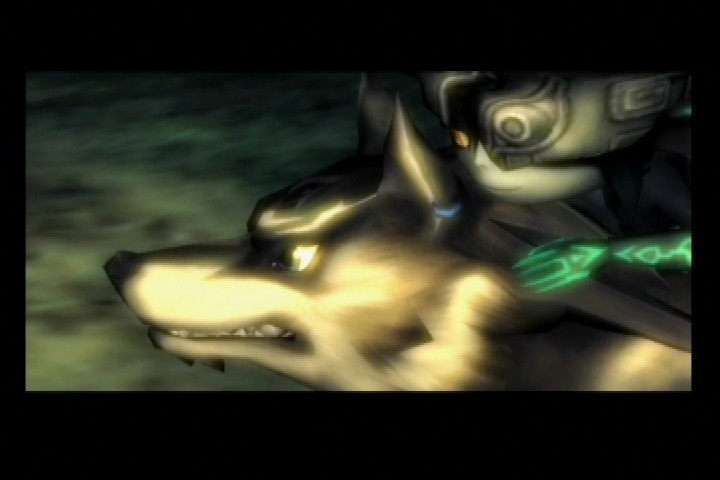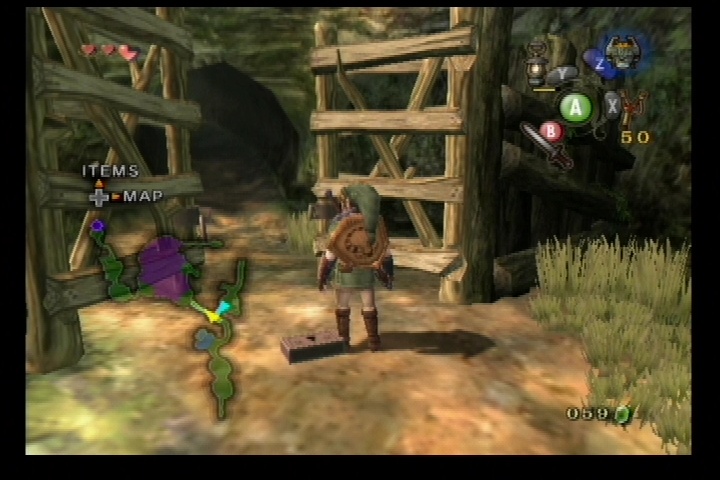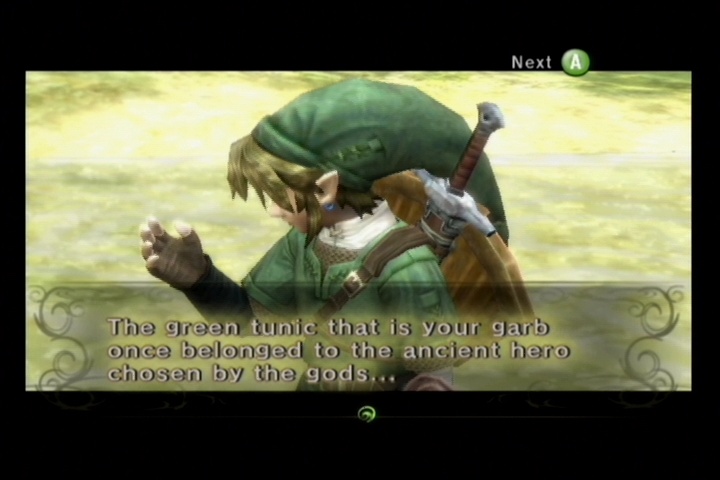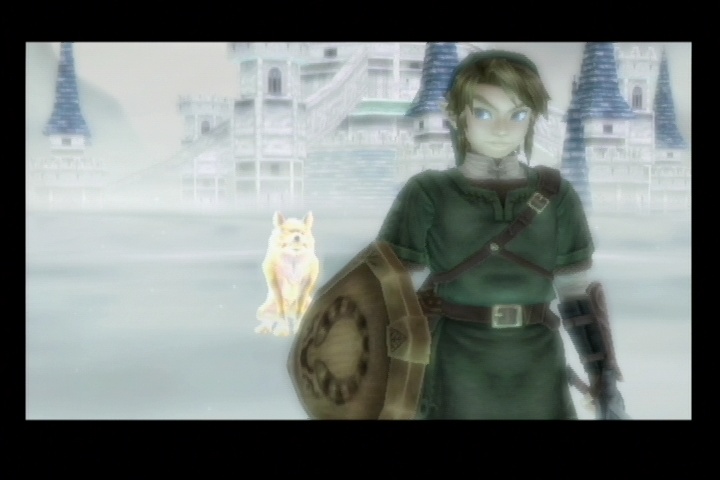When game consoles transitioned from offering primarily 2D games to polygonal 3D games about 10 years ago, all of the tricks and gameplay ideas that developers had been relying on for years flew right out the window. During this time, Nintendo quickly found its footing and released masterful takes on its old franchises that retained the fun and feeling of the older games while properly updating them in exciting and impressive new ways. 1998's The Legend of Zelda: Ocarina of Time was a prime example of this. It featured a more realistic take on the series' fantasy world than ever before, while implementing innovative new controls and offering a good sense of freedom without making the player feel lost. It's one of the greatest games of all time, so it's hard to fault Nintendo for revisiting that same formula. And that's precisely what the latest game in the series, Twilight Princess, does. For the most part, that's a very good thing, because Twilight Princess is a lengthy adventure packed with many well-designed puzzles and some interesting characters. But once you get over the rush of excitement from a big, new Zelda game having finally arrived, it's hard not to feel a tinge of disappointment--there's a very noticeable lack of evolution here, which makes aspects of the game seem more dated than classic. Even so, there isn't much out there that compares to Twilight Princess, except for the Zelda games that have come before it.

Even though Twilight Princess was released first on Nintendo's new console, the Wii, it was originally designed as a GameCube game. Now that both versions are available, it's easy to see how similar the two versions really are. Graphically, the GameCube version is roughly identical to the Wii release. The main difference comes from a lack of 16:9 widescreen support, resulting in many of the story sequences being letterboxed when viewed in 4:3. However, the game does have 480p support. If you're properly equipped with a GameCube component cable and a TV capable of handling the higher resolution, you'll get a slightly cleaner image. The combat controls are more conventional on the GameCube, since you won't be shaking the controller around to attack (though if you've already played the Wii version, expect to feel dumb when you start to shake your WaveBird and wonder why nothing's happening), but the Wii controls actually end up feeling more precise in a direct comparison. It's easier and faster to aim your arrows, boomerang, or other targeted items using the Wii Remote. It's easier to move the camera around with the Wii Remote, too. While the GameCube controller is more precise when it comes to swinging your sword, the easier aiming and faster access to the spin attack make the Wii version's combat controls superior, even though they have a few issues of their own.
Also, in what has to be the weirdest change, the entire GameCube game is a mirror image of the Wii version. Actually, it's probably the other way around--Nintendo flipped the Wii version so that Link would be holding his sword in his right hand, which is the hand you're supposed to use to hold the Wii Remote. Link's a lefty on the GameCube, and the entire world is flipped around, as well. If you've played the Wii version, that'll trip you up a bit, but considering that the most likely candidate for the GameCube version of the game is someone that didn't get a Wii, this isn't a problem in any way. You can't go wrong with either version of the game, but if you're still trying to decide, the Wii version is just a bit better.
Like most other Zelda games, Twilight Princess is a retelling of the same basic tale, though this one is not without its twists. There's a princess named Zelda, a land called Hyrule, and a world that's on the verge of destruction if you don't do something to save it. In this installment, there's a darkness creeping across the land, locking it in the eternal dusk of the twilight realm. You play as Link, a humble, pointy-eared boy who lives in a far-off village and herds goats for a living, yet he ends up getting involved in the conflict. The twilight that's infected the land is an alternate reality of sorts, serving as the game's equivalent of A Link to the Past's dark, alternate world, or in some cases, serving the same purposes as the adult Link/child Link differences in Ocarina. The difference here is that when you're in the twilight, you're transformed into a blue-eyed wolf.
Early on in the game, you meet up with one of the shadow dwellers, an impish little creature named Midna. Midna rides around on your back while you're in wolf form and serves the same purposes as Navi in Ocarina, providing you with the occasional hint. Link's beast form behaves roughly the same as the human form, as far as combat is concerned, but you can't use items. You can, however, access otherwise unreachable areas by following set jump paths that Midna will lead you through. The wolf can also dig and go into a heightened-sense mode that shows off scent trails and other hidden objects. For the first portion of the game, you'll be forced back and forth between forms, but you eventually earn the ability to switch back and forth at will, and some of the game's later puzzles will require you to do just that. You can also ride around on horseback, if you like, but by the time you get to a point when you have large distances to cover, you'll also have the ability to warp around, limiting the horse's usefulness to a couple of combat-oriented sequences.
Many of the early parts of the game take place outside in the game's overworld and in various outdoor areas as you try to clear the darkness from the land. But along the way, you'll also enter various temples and dungeons to collect new items, solve a wide variety of puzzles, and fight bosses. While most of the game's story sequences take place above ground, these temples are the core of the entire game, and they're very well done, even if they cover a lot of the same ground that you may have seen in past Zelda installments. You start out with a forest temple, make your way to a mine under Death Mountain for your fire temple, scratch your head and try to figure out the inner workings of moving water around in the water temple, and so on. That's not to say they're all taken from old blueprints, though, and some of the later temples take you to somewhat more interesting locales, like a sky temple that demands that you make precise use of your grappling hookshot.

For the most part, the puzzles are great and rooted in logic. So if you stare at the map long enough and figure out what each lever-pull does, deducing what's going on in the water temple isn't impossible. And once you get movement-enhancing items like the hookshot, you'll be carefully looking at each wall and ceiling, hoping to see a grapple-friendly target that will move you along. You'll push blocks, you'll move cannonballs from room to room in hopes of finding a cannon and clearing a path, you'll fire arrows at targets that cause blocks to move--it's all pretty standard if you've been keeping up with the Zelda series, but the formula still works quite well. However, with the way the puzzles are designed, it's certainly possible for just about any of them to trip you up and cause you to spend an hour or so just wandering around, staring at everything and trying to figure out what to do next. However, none of the puzzles are especially fiendish, which means that you might catch yourself feeling a little foolish when you finally realize that the solution was staring you in the face the entire time. But really, figuring these puzzles out is where the majority of the fun and sense of reward comes from as you play, because most of it's designed extremely well.
It's good that Twilight Princess' world and puzzle design can carry it, because the combat and boss fights aren't very deep at all. Most enemies just require you to swing your sword at them. You can lock onto enemies with the L trigger and strafe around them, hop back and forth, leap in for a jumping attack, or jump back and out of the way--the same basic moves as past installments. A few enemies require more advanced tactics, like spinning around to get behind them or using one of your items to make them vulnerable. Just about every boss fight in the game requires you to use more than just your sword and shield. Like in every other recent Zelda game, in Twilight Princess you'll find a new item about halfway through a temple, and you can bet that you'll need that item to take on the boss. There are a few tricky parts, but it's certainly feasible that you'll get through the game's 35-to-40-hour story without running out of hearts and dying. That being said, the boss fights make up for some of their ease by being pretty epic. Almost every one pits you against a giant, screen-filling creature that at least looks tough, even if you're just going to grapple your way onto it and stick your sword in its weak spot over and over again, or use your ball and chain to bust it apart, without even breaking a sweat. Even the final confrontation is relatively easy, and if you get stumped going against any boss, you can ask Midna for help and get a fairly good idea about what you're supposed to be doing. If you want to go off the beaten path, you can find a handful of side tasks to take on, like fishing and some other minigames. But aside from the combat-filled Cave of Ordeals, which is a 50-stage area that acts as a survival mode, these aren't too exciting and the rewards you get for completing them aren't especially helpful.

Overall, the game is paced well and it keeps you moving more often than not. At one point you have to move around to various statues that are stashed throughout the world, and this bogs down the action a bit, but it's nowhere near the time sink that the late-game sailing marathon that padded out the back end of Wind Waker was. Your time spent in Twilight Princess involves very little backtracking, and not too much repetition, keeping the focus squarely on original, interesting stuff.
If you spend a lot of time trying to pick apart the visuals of Twilight Princess, you'd notice plenty of low-res textures and jagged edges. But that would be missing the point. Twilight Princess is an excellent-looking game due to some terrific art design. Much has already been said about the art style reverting back to a more mature or realistic look after Wind Waker took the series in a decidedly cartoonlike direction. While there's nothing terribly "mature" about this T-rated game, it looks absolutely great from an artistic perspective. The world itself offers the sort of variety you'd naturally expect from a fantasy game, with everything from lakes to deserts to dungeons, but it's when you start seeing the twilight realm that the game really takes off, visually.
Twilight realm portals that open up do so with an almost Tron-like glowing, computerized look, and when you teleport around or change forms, that same style shows through, breaking your character into cool, tiny black squares and reforming you in a new place or shape. You're also going to fight a lot of crazy-looking dark shadow creatures, and many of the enemies in Twilight Princess look really nice, up to and including those large boss opponents. At the same time, the game gets a lot of little details right, too. You get a lot of close shots of characters' faces in the game's cutscenes, and their faces are often filled with emotion. The eyes, particularly, convey a lot of soul, which really helps make Link's wolf form work, too. It may have its rough edges here and there, but Twilight Princess is a superb-looking GameCube game.
The Legend of Zelda series' symphonic-style music has always been great, dating all the way back to the NES original. That same music keeps getting updated, and more new themes have worked their way into the series and become recurring, as well. You'll hear a lot of classic melodies in Twilight Princess, and those help give the game a nostalgic feel. Much like the graphical portion of the game, the music gets by on the strength of the compositions, but at the same time, all of the music is rendered in the same sort of sample-driven, synthesized style that the series has had since the Nintendo 64 days. While that might also give you a dose of nostalgia, it's also a little dated. When you consider the storage limitations that are inherent to the GameCube, it's easy to see why the game went this route and also why it relies on text and text alone to convey its epic story. The rest of Twilight Princess' sound is about what you'd expect, and it's using plenty of the same sort of sound effects and battle yelps that the series has relied on, which again will tap into fans' nostalgia for the series. All in all, the game sounds great.

Objectively speaking, it's still a little disappointing that the series hasn't evolved much at all with this latest installment. You'll almost certainly enjoy the game for its terrific puzzles, colorful characters, and compelling story, but at some point the feeling of nostalgia crosses the line and holds this game back from being as unbelievably good as some of its predecessors. So as impressive of a game as it is, Twilight Princess seems like it could have been so much more if Nintendo had broken from the formula a little bit more. But even without that, Twilight Princess is a great game that stays extremely true to the Zelda franchise's past. That's excellent news for fans of the series, who'll find in Twilight Princess a true-blue Zelda game with updated visuals, some new twists, plenty of challenging puzzles, and a faithful dedication to the series' roots.
Editor's note 12/15/06: The original version of this review overlooked an alternate method for performing the spin attack. GameSpot regrets the error.